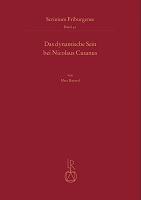Das dynamische Sein bei Nicolaus Cusanus
Ein Beitrag zur Begriffsgeschichte der dynamischen Ontologie
| dc.contributor.author | Bayard, Marc | |
| dc.date.accessioned | 2022-11-04T13:25:40Z | |
| dc.date.available | 2022-11-04T13:25:40Z | |
| dc.date.issued | 2019 | |
| dc.identifier | OCN: 1368431800 | |
| dc.identifier.uri | https://library.oapen.org/handle/20.500.12657/59159 | |
| dc.description.abstract | Esse est movere - to be is to move. Contrary to our static notions of medieval philosophy, Nicolaus Cusanus in the 15th century sketches a dynamic view of the world in which creatures are independent and self-acting beings. For the elaboration of this dynamic ontology, the study offers a concept-historical analysis of dynamics: the dynamis of the Aristotelian doctrine of movement leads via the Neoplatonic 'force' and the 'divine omnipotence' of the patristic period to the medieval potentia. The philosophical starting point is contemporary process philosophy, for which Cusanus' dynamic approach certainly represents an opportunity. | en_US |
| dc.language | German | en_US |
| dc.relation.ispartofseries | Scrinium Friburgense | en_US |
| dc.subject.other | Middle Ages; Literature; Aristotle; Dynamics; Mediaevistics; Process Philosophis | en_US |
| dc.title | Das dynamische Sein bei Nicolaus Cusanus | en_US |
| dc.title.alternative | Ein Beitrag zur Begriffsgeschichte der dynamischen Ontologie | en_US |
| dc.type | book | |
| oapen.identifier.doi | 10.29091/9783954906222 | en_US |
| oapen.relation.isPublishedBy | daaaf3b1-abc7-47a7-aa90-02109be28984 | en_US |
| oapen.relation.isFundedBy | 07f61e34-5b96-49f0-9860-c87dd8228f26 | en_US |
| oapen.relation.isbn | 9783954904044 | en_US |
| oapen.collection | Swiss National Science Foundation (SNF) | en_US |
| oapen.series.number | 42 | en_US |
| oapen.pages | 344 | en_US |

